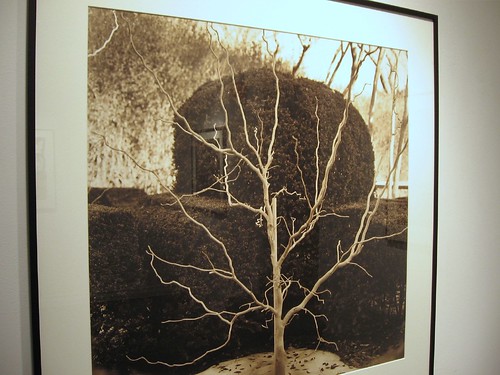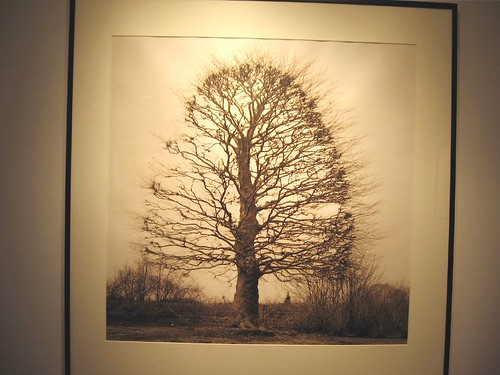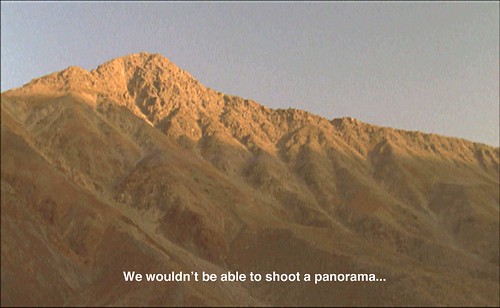
Marine Hugonnier, Ariana, 2003, Super 16 mm of film (color) transferred to DVD, 18 minutes, 36 seconds. Image courtesy of the Artist and Max Wigram Gallery, London, UK.
Point of view and landscapes are political. And while Marine Hugonnier’s Trilogy at the Philadelphia Museum of Art is more about the politics of these things in the real world, I couldn’t help but think that her ideas applied equally well to the landscape canvas.
The first film in her Trilogy, Ariana, is screening until May 20. Here’s the schedule for the rest.
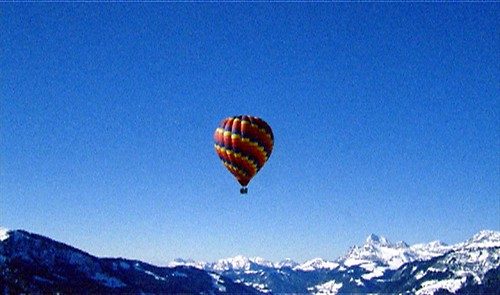
In Ariana, Hugonnier and her film crew are trying to reach a vista in Afghanistan, only to be blocked from their mission by the Afghan government. In the other two films of the Trilogy, The Last Tour and Travelling Amazonia, Hugonnier takes her issues of travel and land and insider-outsider to the Swiss Alps and to Brazil.
In the course of the quest in Afghanistan, Hugonnier discusses how the view from on high is about power and control of land. She throws in a little history about wars and war lords, and then she throws in her own current situation of being thwarted from seeing the view.
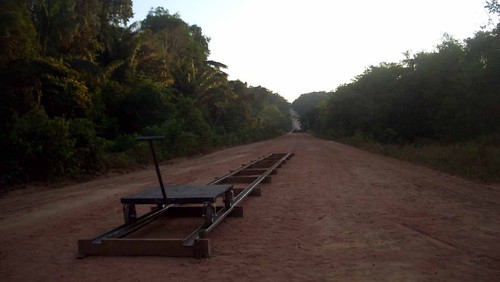
Marine Hugonnier, Travelling Amazonia, part 3 of Trilogy, 2006, Super 16 mm of film (color) transferred to DVD, 23 minutes, 52 seconds. Image courtesy of the Artist and Max Wigram Gallery, London, UK.
Questions come up in the course of the film of whether she and her crew–tourists, there for but a moment in time–will ever see things from the same point of view as the Afghan government. Although the film is a little slow, with seemingly interminable black-screen transitions (dead ends and blind corners?), I found myself intrigued by the issues being raised. Curiosity, desire thwarted, time wasted, vision blocked, power and powerlessness, the cultures of East vs. West, the skewed view of the temporary tourist, the quick tourist snapshot–all were fodder for thought, thanks to the way the film rolls out its story.
I also was reminded of how the art landscape, when it’s doing what it’s supposed to be doing (in my personal philosophy of art), is not really an image of nature. It’s a meditation on the relationship of nature to what’s happening in the world, as well as on the relationship to the artist and all of humanity. Whether it’s the path of life in Dutch Golden Age landscapes or the romanticized views presented at the time when industrialization was making its mark on the natural world, it’s about powerful thoughts and powerless thoughts. Landscape is metaphor.
Two shows I saw recently at Schmidt/Dean Gallery, also brought these thoughts to mind. Paintings by William Smith and photographs by Linda Adelstein of metaphoric landscapes and literal landscapes made me think perhaps it’s not such a dead genre after all. (See our new intern, Sarah’s, take on William Smith here).
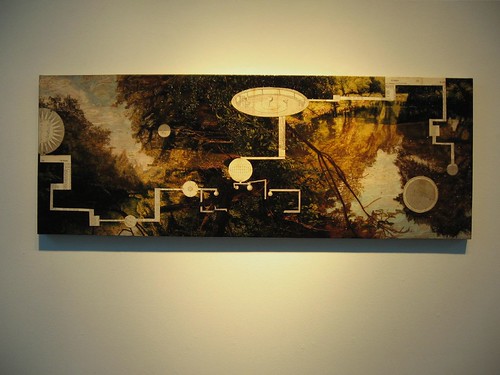
William Smith, Of Eclipses, 2007, oil on book pages from Ferguson’s Anatomy, printed 1799, 16 x 43.5″
Smith’s paintings on old text pages of landscapes, as well as on canvas and prints, generally lack horizon. Not looking up, choosing to have no horizon, is about refusing to confront the present state of the landscape as it really is. Only by looking down can we catch bits of pristine-looking nature. This approach is both romantic and desperate, a last-ditch effort to stay in traditional nature.
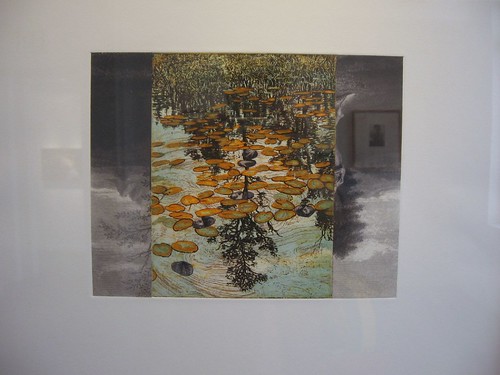
Smith’s Et in Arcadia, etching, digital chine colle 8″ x 10″
This idea of looking down in landscape is usually related to air travel, and the notion of landscape viewed from a plane. The Western landscape tradition prior to air travel generally consisted of earth below and sky above. Smith is sly however, giving us a sky reflected in the water, thereby reflecting the change in our relationship to the sky, having touched it, kissed it, made it our own space. For all the relationship between air-travel and the bird’s eye landscape, Smith is relentlessly unmappy, and inserts a delicate intimacy with the landscape.
That intimacy with nature reminds me of Asian landscapes, and Stuart Rome’s photographs. But these paintings don’t have Rome’s transcendence. Smith is more about himself and the human mind. In the layered paintings in which older thoughts and ideas come through, the paintings become romantic salutes to past bodies of knowledge, past art, and the past in general. Part of what interests me about Smith, besides the obvious beauty of his work, is the apparent paradox of looking backward and beneath the surface to comment on the present as well as jump backwards into the past.
Adelstein’s toned photographs, some of them taken at the Madoo Conservancy in Sagaponack (on Long Island), some in England, evoke a transcendent sense of light and life force. But the iconic trees are portraits of not just vitality–they are also portraits of decorum. Adelstein’s point of view seems to focus on nature restrained and tamed by man. The photos of the individual trees remind me of Rodney Graham’s powerful upside-down trees.
Adelstein treats the trees with great respect, as if they are mages or wise elders. But ultimately, her work is about a lifestyle that’s no longer possible. Her photographic methods and use of toning also suggest a looking backward. Which brings me back to political power and who owns what and who sees what how.
Ultimately landscape artists lay claim to the landscape they paint and make it their own, project their values onto it, paint their perspective onto the canvas, reveal their interior thoughts. Landscape is about taking control over the earth, nature, the land. And what’s that, if not political?
These shows at Schmidt/Dean are up until May 18.


